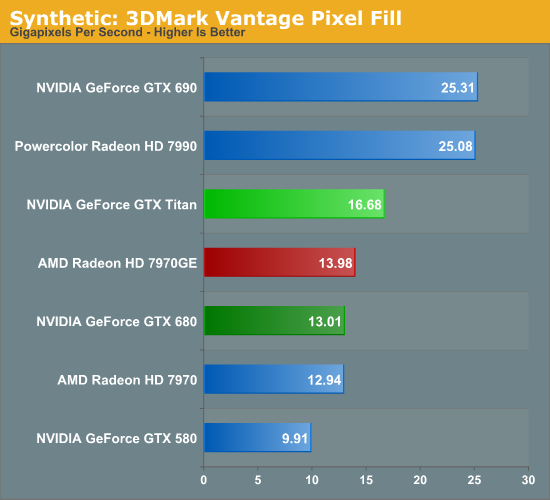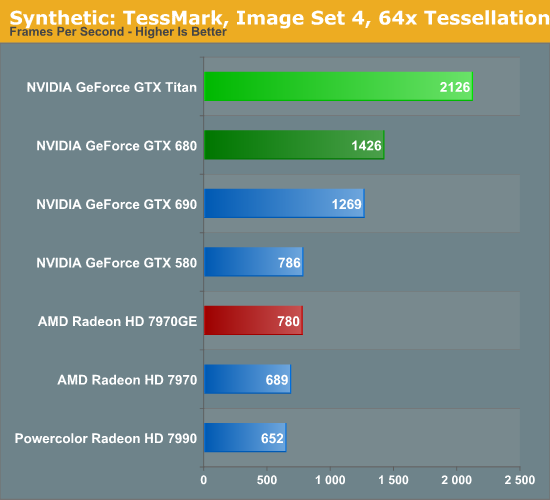NVIDIA’s GeForce GTX Titan Review, Part 2: Titan's Performance Unveiled
by Ryan Smith & Rahul Garg on February 21, 2013 9:00 AM ESTSynthetics
As always we’ll also take a quick look at synthetic performance to get a better look at Titan’s underpinnings. These tests are mostly for comparing cards from within a manufacturer, as opposed to directly comparing AMD and NVIDIA cards. We’ll start with 3DMark Vantage’s Pixel Fill test.

Pixel fill is a mix of a ROP test and a test to see if you have enough bandwidth to feed those ROPs. At the same time the smallest increase in theoretical performance for Titan over GTX 680 was in ROP performance, where a 50% increase in ROPs was met with a minor clockspeed reduction for a final increase in ROP performance of 25%.
The end result is that with gains of 28%, Titan’s lead over GTX 680 is just a hair more than its increase in theoretical ROP performance. Consequently at first glance it looks like Titan has enough memory and cache bandwidth to feed its 48 ROPs, which given where we’re at today with GDDR5 is good news as GDDR5 has very nearly run out of room.
Moving on, we have our 3DMark Vantage texture fillrate test, which does for texels and texture mapping units what the previous test does for ROPs.

Oddly enough, despite the fact that Titan’s texture performance improvements over GTX 680 were only on the range of 46%, here Titan is measured as having 62% more texturing performance. This may be how Titan is interplaying with its improved bandwidth, or it may be a case where some of the ancillary changes NVIDIA made to the texture paths for compute are somehow also beneficial to proper texturing performance.
Finally we’ll take a quick look at tessellation performance with TessMark.

Unsurprisingly, Titan is well ahead of anything else NVIDIA produces. At 49% faster it’s just a bit over the 46% theoretical performance improvement we would expect from the increased number of Polymorph Engines the extra 6 SMXes bring. Interestingly, as fast as GTX 580’s tessellation performance was, these results would indicate that Titan offers more than a generational jump in tessellation performance, nearly tripling GTX 580’s tessellation performance. Though at this time it’s not at all clear just what such tessellation performance is good for, as we seem to be reaching increasingly ridiculous levels.










337 Comments
View All Comments
ponderous - Thursday, February 21, 2013 - link
Cannot give kudos to what is a well performing card when it is so grosslyout of order in price for the performance. $1000 card for 35% more performance
than the $450 GTX680. A $1000 card that is 20% slower than the $1000 GTX690.
And a $1000 card that is 30% slower than a $900 GTX680SLI solution.
Meet the 'Titan'(aka over-priced GTX680).
Well here we have it, the 'real' GTX680 with a special name and a 'special'
price. Nvidia just trolled us with this card. It was not enough for them to
sell a mid-ranged card for $500 as the 'GTX680', now we have 'Titan' for twice
the price and an unremarkable performance level from the obvious genuine successor
to GF110(GTX580).
At this irrational price, this 'Titanic' amusement park ride is not one worth
standing in line to buy a ticket for, before it inevitably sinks,
along with its price.
wreckeysroll - Thursday, February 21, 2013 - link
now there is some good fps numbers for titan. we expected to see such. shocked to see it with the same performance as 7970ghz in that test although!much too much retail msrp for the card. unclear what nvidia was thinking. msrp is sitting far too high for this unfortunately
quantumsills - Thursday, February 21, 2013 - link
Wow....Some respectable performance turn-out here. The compute functionality is formidable, albeit the value of such is questionable in what is a consumer gaming card.
A g-note though ? Really nvidia ? At what degree of inebriation was the conclusion drawn that this justifies a thousand dollar price tag ?
Signed
Flabbergasted.
RussianSensation - Thursday, February 21, 2013 - link
Compute functionality is nothing special. Still can't bitcoin mine well, sucks at OpenCL (http://www.computerbase.de/artikel/grafikkarten/20... and if you need double precision, well a $500 Asus Matrix Platinum @ 1300mhz gives you 1.33 Tflops. You really need to know specific apps you are going to run on this like Adobe CS6 or very specific CUDA compute programs to make it worthwhile as a non-gaming card.JarredWalton - Thursday, February 21, 2013 - link
Really? People are going to trot out Bitcoin still? I realize AMD does well there, but if you're serious about BTC you'd be looking at FPGAs or trying your luck at getting one of the ASICs. I hear those are supposed to be shipping in quantity some time soon, at which point I suspect prices of BTC will plummet as the early ASIC owners cash out to pay for more hardware.RussianSensation - Thursday, February 28, 2013 - link
It's not about bitcoin mining alone. What specific compute programs outside of scientific research does the Titan excel at? It fails at OpenCL, what about ray-tracing in Luxmark? Let's compare its performance in many double precision distributed computing projects (MilkyWay@Home, CollatzConjecture), run it through DirectCompute benches, etc.http://www.computerbase.de/artikel/grafikkarten/20...
So far in this review covers the Titan's performance from specific scientific work done by universities. But those types of researchers get grants to buy full-fledged Tesla cards. The compute analysis in the review is too brief to conclude that it's the best compute card. Even the Elcomsoft password hashing - well AMD cards perform faster there too but they weren't tested. My point is it's not true to say this card is unmatched in compute. It's only true in specific apps. Also, leaving full double precision compute doesn't justify its price tag either since AMD cards have had non-gimped DP for 5+ years now.
maxcellerate - Thursday, March 28, 2013 - link
I tend to argee with RussianSensation, though the fact is that the first batch of Titans has sold out. But to who? There will be the odd mad gamer who must have the latest most expensive card in their rig, regardless. But I suspect the majority of sales have gone to CG renderers where CUDA still rules and $1000 for this card is a bargain compared to what they would have paid for it as a Quadra. Once sales to that market have dried up, the price will drop.Then I can have one;)
ponderous - Thursday, February 21, 2013 - link
True. Very disappointing card. Not enough performance for the exorbitant cost.Nvidia made a fumble here on the cost. Will be interesting to watch in the coming months where the sure to come price drops wind up placing the actual value of this card at.
CeriseCogburn - Saturday, February 23, 2013 - link
LOL - now compute doesn't matter - thank you RS for the 180 degree flip flop, right on schedule...RussianSensation - Thursday, February 28, 2013 - link
I never said compute doesn't matter. I said the Titan's "out of this world compute performance" needs to be better substantiated. Compute covers a lot of apps, bitcoin, openCL, distributed computing projects. None of these are mentioned.